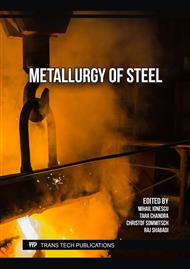p.47
p.53
p.61
p.81
p.87
p.93
p.99
p.105
p.111
Grain Refinement in 441 Ferritic Stainless Steel: High Versus Low Ti/Al Ratio after Casting and Hot Rolling
Abstract:
The effect of Ti/Al ratio (mass%) on the evolution of the microstructures after casting and hot rolling of Ca treated 441 dual stabilized ferritic stainless steel (FSS) was investigated in order to understand its effects on grain refinement mechanism. Industrially cast and lab simulated hot rolled samples, were subjected to similar processing conditions but with different Ti/Al ratios of 2.4 and 7.8. The microstructures and inclusions were analysed by the OM, SEM-EDS, SEM-EBSD and AzTecFeature software. The results showed that the steel with higher Ti/Al ratio exhibited finer grains after continuous casting and hot rolling, i.e., the initial finer as-cast structure resulted in finer grains and less substructure after hot rolling. The steel with higher Ti/Al ratio contained more Ti-rich complex inclusions and precipitates (especially TiN), which led to more heterogeneous nucleation of the 𝜹-ferrite and grain refinement during solidification. On the contrary, the steel with low Ti/Al ratio exhibited coarser as-cast grain structure, less recrystallization and higher volume fraction of substructure after hot rolling. Therefore, it was deduced that the Ti/Al ratio is one of the essential parameters to achieving grain refinement in Ca treated 441 FSS during continuous casting.
Info:
Periodical:
Pages:
87-92
Citation:
Online since:
November 2023
Authors:
Keywords:
Price:
Сopyright:
© 2023 Trans Tech Publications Ltd. All Rights Reserved
Share:
Citation:



